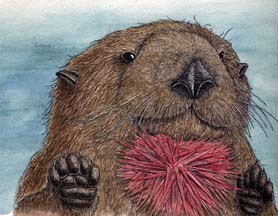

In the 1700-1800s, on the coast of California, the sea otter was hunted for its sleek, beautiful fur. It was also killed by fishermen who thought they were eating too many of the fish they wanted to catch. The sea otters were hunted almost to extinction.
Without the sea otter, fishermen began to see changes in the ecosystem. Sea otters are one of the few animals that can eat sea urchins. When the otters disappeared, the sea urchin population grew very quickly. Soon there were more sea urchins on the California coast than ever before. Sea urchins eat kelp. With so many more sea urchins, they ate up all the kelp beds. The kelp beds are very important to many fish as a place to have their young. This set off a chain reaction. With the otters gone and the sea urchins numbers growing quickly, the kelp beds began to disappear. Then the fish, with no safe place to spawn, began to disappear. In just a few years, the fishermen noticed that the fish were suddenly gone.
Killing off the sea otter had the opposite effect they had hoped. They didn’t know the sea otter actually helped protect the fish populations by eating sea urchins. The sea otter is a keystone species for its ecosystem.
In 1911, a treaty was passed to protected the sea otters from hunting. This was called the International Fur Seal Treaty. In some areas the sea otters came back. The sea urchins in those areas were brought back into control. Their kelp beds recovered and the fish population came back too. This is an example of how a keystone species is interconnected with a whole ecosystem.
Support efforts to protect endangered species and be aware that one species can affect all the others in its habitat.
(Included in PDF)
Keystone Species - Otters, Alligators and Elephants - Read and React
1. What happened to the other species in the coastal waters when the sea otter was hunted almost to extinction:
2. What was the balance between the American alligator, the gar and the game fish?
3. How does the elephant keep the African savannah habitat right for the other animals living there?
When you research information you must cite the reference. Citing for websites is different from citing from books, magazines and periodicals. The style of citing shown here is from the MLA Style Citations (Modern Language Association).
When citing a WEBSITE the general format is as follows.
Author Last Name, First Name(s). "Title: Subtitle of Part of Web Page, if appropriate." Title: Subtitle: Section of Page if appropriate. Sponsoring/Publishing Agency, If Given. Additional significant descriptive information. Date of Electronic Publication or other Date, such as Last Updated. Day Month Year of access < URL >.
Amsel, Sheri. "Keystone Species - Sea Otter" Exploring Nature Educational Resource ©2005-2024. December 13, 2024
< http://www.exploringnature.org/db/view/Keystone-Species-Sea-Otter >
